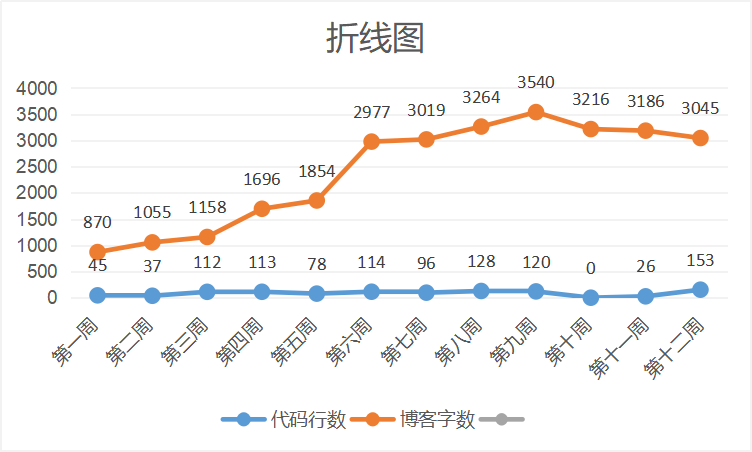2019第十二周作业
| 这个作业属于哪个课程 | C语言程序设计ll |
| 这个作业要求在哪里 | (https://edu.cnblogs.com/campus/zswxy/software-engineering-class2-2018/homework/3234) |
| 我在这个课程的目标是 | 能够掌握二级指针的概念,以及指针数组的应用;了解指针与函数的关系,掌握指针作为函数返回值;掌握单向链表的概念和操作 |
| 这个作业在哪个具体方面帮助我实现目标 | 了解了指针函数和函数指针的区别 |
| 参考文献 | (https://blog.csdn.net/u012741741/article/details/66478883) |
一、基础题
1、 计算最长的字符串长度 (15 分)
本题要求实现一个函数,用于计算有n个元素的指针数组s中最长的字符串的长度。
函数接口定义:
int max_len( char *s[], int n );
其中n个字符串存储在s[]中,函数max_len应返回其中最长字符串的长度。
裁判测试程序样例:
#include <stdio.h>
#include <string.h>
#include <stdlib.h>
#define MAXN 10
#define MAXS 20
int max_len( char *s[], int n );
int main()
{
int i, n;
char *string[MAXN] = {NULL};
scanf("%d", &n);
for(i = 0; i < n; i++)
{
string[i] = (char *)malloc(sizeof(char)*MAXS);
scanf("%s", string[i]);
}
printf("%d
", max_len(string, n));
return 0;
}
/* 你的代码将被嵌在这里 */
输入样例:
4
blue
yellow
red
green
输出样例:
6
(1)实验代码
#include <stdio.h>
#include <string.h>
#include <stdlib.h>
#define MAXN 10
#define MAXS 20
int max_len( char *s[], int n );
int main()
{
int i, n;
char *string[MAXN] = {NULL};
scanf("%d", &n);
for(i = 0; i < n; i++)
{
string[i] = (char *)malloc(sizeof(char)*MAXS);
scanf("%s", string[i]);
}
printf("%d
", max_len(string, n));
return 0;
}
int max_len(char *s[],int n)
{
int i,max=0;
for(i=0;i<n;i++)
{
int len = strlen(s[i]);
if(len>max)
{
max=len;
}
}
return max;
}
(2)设计思路
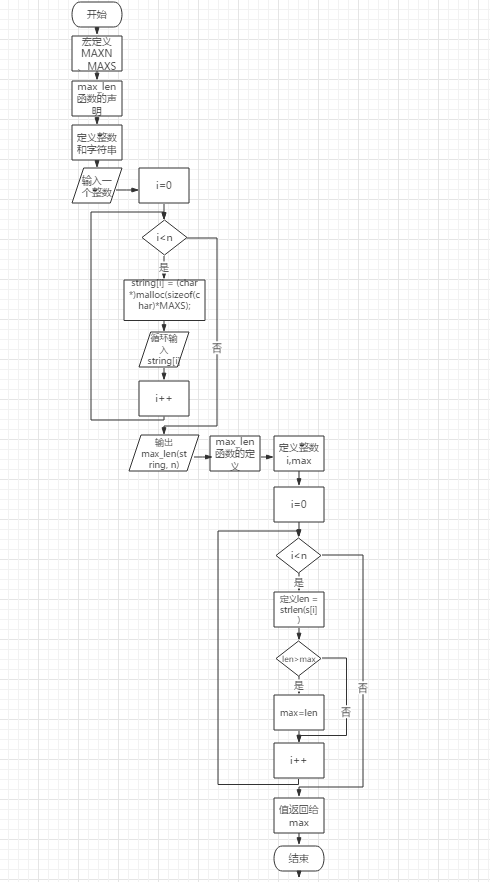
(3)本题调试过程中碰到问题及解决方法
本题在调试过程中没有遇到任何问题
(4)运行结果截图
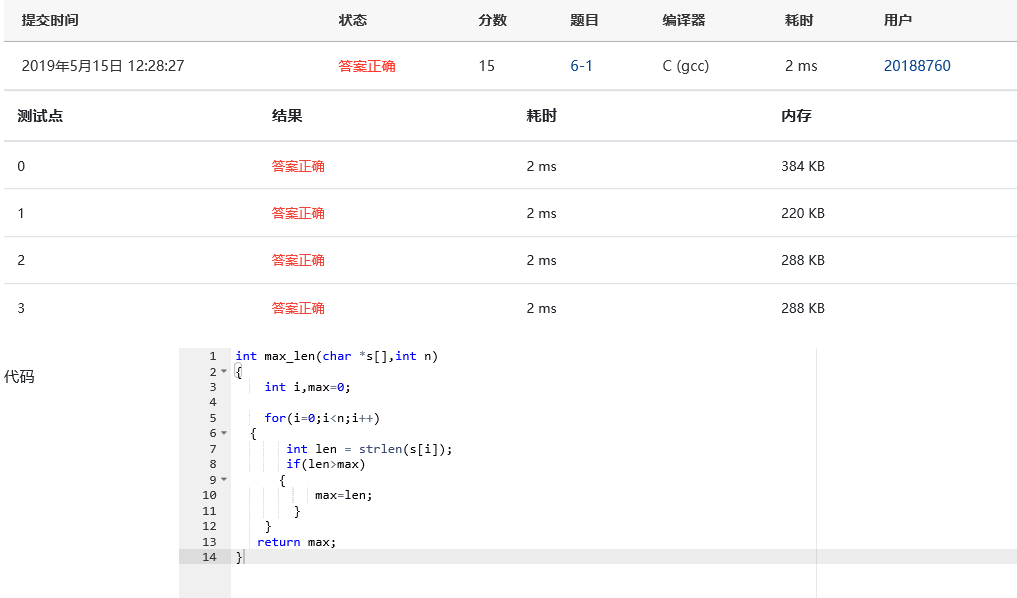
2、统计专业人数 (15 分)
本题要求实现一个函数,统计学生学号链表中专业为计算机的学生人数。链表结点定义如下:
struct ListNode {
char code[8];
struct ListNode *next;
};
这里学生的学号共7位数字,其中第2、3位是专业编号。计算机专业的编号为02。
函数接口定义:
int countcs( struct ListNode *head );
其中head是用户传入的学生学号链表的头指针;函数countcs统计并返回head链表中专业为计算机的学生人数。
裁判测试程序样例:
#include <stdio.h>
#include <stdlib.h>
#include <string.h>
struct ListNode {
char code[8];
struct ListNode *next;
};
struct ListNode *createlist(); /*裁判实现,细节不表*/
int countcs( struct ListNode *head );
int main()
{
struct ListNode *head;
head = createlist();
printf("%d
", countcs(head));
return 0;
}
/* 你的代码将被嵌在这里 */
输入样例:
1021202
2022310
8102134
1030912
3110203
4021205
#
输出样例:
3
(1)实验代码
#include <stdio.h>
#include <stdlib.h>
#include <string.h>
struct ListNode {
char code[8];
struct ListNode *next;
};
struct ListNode *createlist(); /*裁判实现,细节不表*/
int countcs( struct ListNode *head );
int main()
{
struct ListNode *head;
head = createlist();
printf("%d
", countcs(head));
return 0;
}
int countcs(struct ListNode *head)
{
int sum=0;
while(head) //用计数器记录字符串第二三个是否为02就可以了
{
if(head -> code[1] == '0' && head -> code[2] == '2') //指向运算符->
{
sum++;
}
head = head -> next;
}
return sum;
}
(2)设计思路
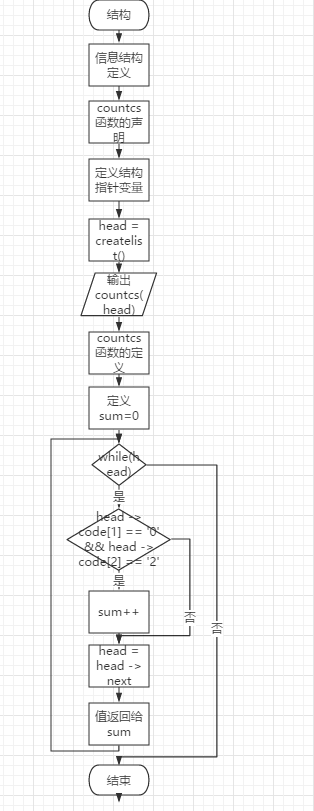
(3)本题调试过程中碰到问题及解决方法
问题:·一开始while语句的条件不会写,导致编译错误
解决方法:·问了我的搭档,然后看了其他博主的博客
(4)运行结果截图
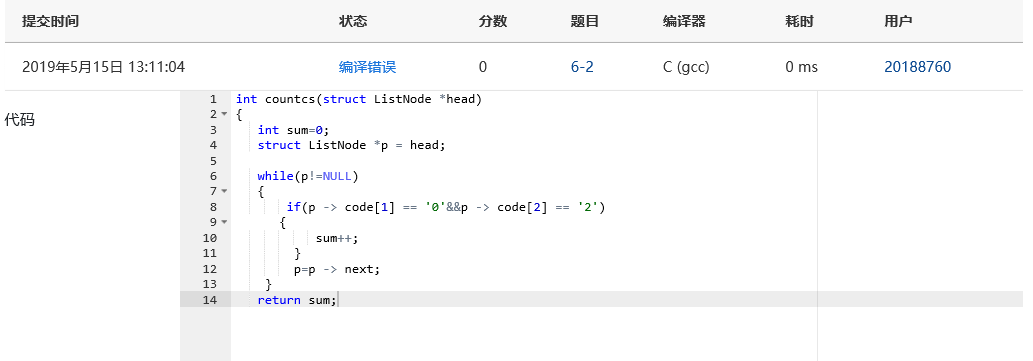

3、删除单链表偶数节点 (20 分)
本题要求实现两个函数,分别将读入的数据存储为单链表、将链表中偶数值的结点删除。链表结点定义如下:
struct ListNode {
int data;
struct ListNode *next;
};
函数接口定义:
struct ListNode *createlist();
struct ListNode *deleteeven( struct ListNode *head );
函数createlist从标准输入读入一系列正整数,按照读入顺序建立单链表。当读到−1时表示输入结束,函数应返回指向单链表头结点的指针。
函数deleteeven将单链表head中偶数值的结点删除,返回结果链表的头指针。
裁判测试程序样例:
#include <stdio.h>
#include <stdlib.h>
struct ListNode {
int data;
struct ListNode *next;
};
struct ListNode *createlist();
struct ListNode *deleteeven( struct ListNode *head );
void printlist( struct ListNode *head )
{
struct ListNode *p = head;
while (p) {
printf("%d ", p->data);
p = p->next;
}
printf("
");
}
int main()
{
struct ListNode *head;
head = createlist();
head = deleteeven(head);
printlist(head);
return 0;
}
/* 你的代码将被嵌在这里 */
输入样例:
1 2 2 3 4 5 6 7 -1
输出样例:
1 3 5 7
(1)实验代码
#include <stdio.h>
#include <stdlib.h>
struct ListNode {
int data;
struct ListNode *next;
};
struct ListNode *createlist();
struct ListNode *deleteeven( struct ListNode *head );
void printlist( struct ListNode *head )
{
struct ListNode *p = head;
while (p) {
printf("%d ", p->data);
p = p->next;
}
printf("
");
}
int main()
{
struct ListNode *head;
head = createlist();
head = deleteeven(head);
printlist(head);
return 0;
}
struct ListNode *createlist()
{
struct ListNode *head,*p;
head = (struct ListNode *)malloc(sizeof(struct ListNode));
p = head;
head->next=NULL; //指向运算符->
int num;
while(scanf("%d",&num)!=EOF&&num!=-1)
{
p->next= (struct ListNode *)malloc(sizeof(struct ListNode));
p=p->next;
p-> data=num;
p->next=NULL;
}
head=head->next;
return (head);
}
struct ListNode *deleteeven(struct ListNode *head)
{
struct ListNode *p,*a;
if(head == NULL)
{
return NULL;
}
p=head;
a=p->next;
while(a!=NULL)
{
if(a->data%2==0)
{
p->next=a->next;
free(a);
a=p->next;
}
else
{
p=p->next;
a=p->next;
}
}
if(head->data%2==0)
{
head=head->next;
}
return(head);
}
(2)设计思路
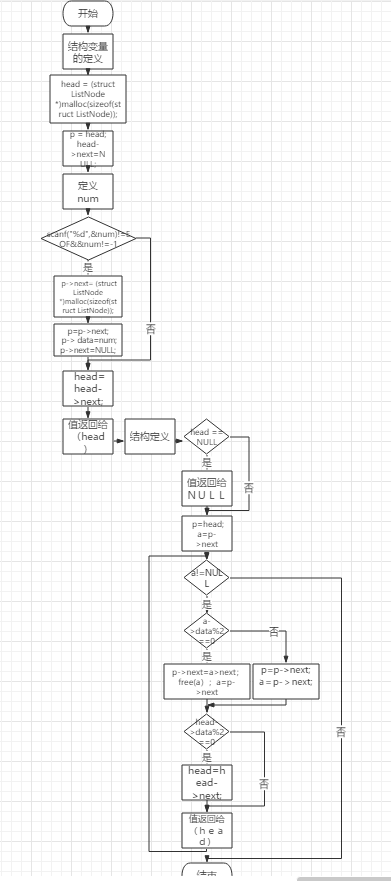
(3)本题调试过程中碰到问题及解决方法
问题:本题不太会做,想法简单,做起来难。感觉要想清楚的点有很多。while语句及if语句的判断条件我不会写。
解决方法:查了资料,看了其他博客的代码,上面这个代码就是看的别人的代码,正在努力读懂及理解中
(4)运行结果截图
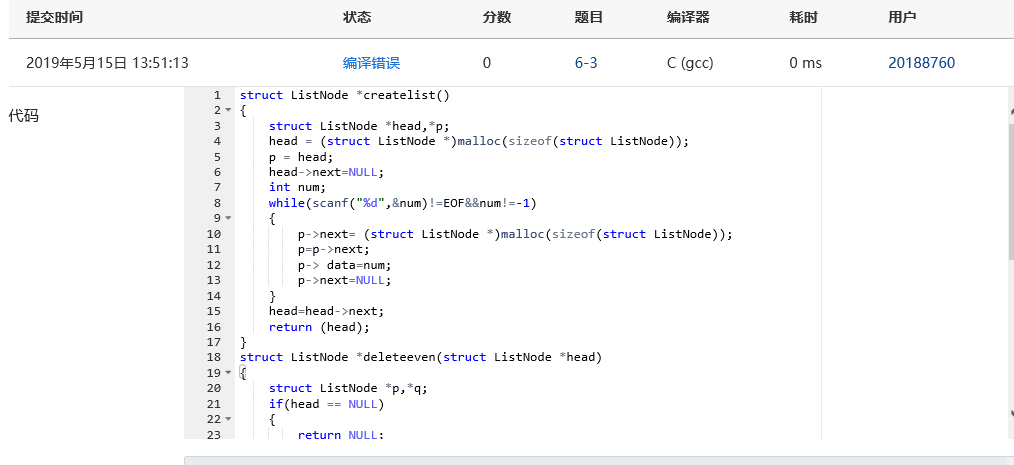

二、学习感悟
本周学习了第11章指针进阶,主要讲了以下几点的区别及用法:
数组指针:数组指针强调的是指针,并且这个指针指向一个数组,即指针变量存放的是数组地址。eg:int (a)[10],其中a是一个指针,并且指向一个含有10个整型元素的数组。
指针数组:指针数组强调的是数组,并且数组元素是指针类型。eg:int a[10],其中a是一个数组,数组元素是指针(int)。
指针函数:指针函数指带有指针的函数,即其本质是一个函数,只不过这种函数返回的是一个对应类型的地址。eg:int function(int m){printf("this is a function");return m; } int main(){int p, data = 5;p = function(&data);printf("%d
", p); //打印出data的值}
函数指针:函数指针是指向可执行代码段或调用可执行代码段的信息块的指针,而不是指向某种数据的指针。函数指针是将函数当做普通数据那样存储和管理。eg:void test(char str);void (p)(char),其中p是一个指针,并且指向一个函数,这个函数参数是char,返回类型是void型。
二级指针:二级指针指的是A(即B的地址)是指向指针的指针,用于存放二级指针的变量称为二级指针变量.根据B的不同情况,二级指针又分为指向指针变量的指针和指向数组的指针。eg:int i,p,**pi;p=&i; pi=π
单向链表:单向链表(单链表)是链表的一种,其特点是链表的链接方向是单向的,对链表的访问要通过顺序读取从头部开始。 通过指针连接起来,但是只能单向遍历的内存块。eg:这里有一个单向链表的经典示例
感悟:感觉这周的作业前两题还行,最后一题对我来说比较难。继续努力吧!加油!
三、预习作业
1.所在小组想要开发的项目的名称和目标
开发的项目名称:贪吃蛇
目标:能清楚的把贪吃蛇这个游戏搞出来
2.项目主体功能的描述
首先先构造出小蛇,让小蛇移动,然后让玩家控制小蛇移动,让系统判断游戏失败,最后让小蛇吃食物增加长度。
3.现阶段已做的准备工作
初步定了游戏开发项目,然后了解游戏内容,打算继续看书,深入了解游戏并开发
4.小组成员名单和进度安排。(课程设计阶段:13-17周)
小组成员:熊亚婷,章满,张英杰
进度安排:初步定了游戏,后期小组将继续讨论游戏,完成游戏的后期操作
四、结对编程感想
本周三晚自习依旧是我们结对编程的时间,我和搭档在寝室讨论了一番,但是还是有很多地方不清楚,我们俩都不会最后一题。然后就各自查资料了,总的来说还是有收获的。
五、学习进度条
| 周/日期 | 这周所花的时间 | 代码行数 | 学到的知识点简介 | 目前比较迷惑的问题 |
|---|---|---|---|---|
| 2/25-3/3 | 三天 | 45 | 数组的认识及用法 | 数组长度的理解 |
| 3/4-3/10 | 两天 | 37 | 编写程序时处理文件 | fscanf与fprintf的具体用法 |
| 3/11-3/17 | 三天 | 53 | 二维数组的使用及文件插入 | 二维数组的用法、上三角的判断及文件的处理 |
| 3/18-3/24 | 两天 | 113 | 选择排序法、二分查找法、二维数组的引用与矩阵 | 不清楚选择排序法和冒泡排序法的区别 |
| 3/25-3/31 | 两天 | 78 | 判断回文、一维字符数组的用法、使用字符串编程 | 使用字符串编程 |
| 4/1-4/7 | 两天 | 88 | 指针变量的基本运算,内存单元和地址之间的关系 | 不太了解指针数组 |
| 4/8-4/14 | 两天 | 96 | 指针、数组和地址之间的关系 | 对于指针数组和数组指针的区别不是特别清楚 |
| 4/15-4/21 | 两天 | 128 | 字符串和字符指针、常用的字符串处理函数 及用指针实现内存动态分配 | 对于指针都不是特别懂 |
| 4/22-4/28 | 两天 | 120 | 定义结构,使用结构变量与结构数组进行编程 | 结构体参与判断 |
| 4/29-5/4 | 一天 | 0 | 结构数组及结构指针 | 结构指针 |
| 5/5-5/11 | 两天 | 26 | 递归函数的定义及使用 | 递归函数的使用 |
| 5/12-5/18 | 两天 | 153 | 指针函数与函数指针的区别 | 不太会用二级指针 |
六、表格和折线图
| 时间 | 代码行数 | 博客字数 |
|---|---|---|
| 第一周 | 45 | 870 |
| 第二周 | 37 | 1055 |
| 第三周 | 112 | 1158 |
| 第四周 | 113 | 1696 |
| 第五周 | 78 | 1854 |
| 第六周 | 114 | 2977 |
| 第七周 | 96 | 3019 |
| 第八周 | 128 | 3264 |
| 第九周 | 120 | 3540 |
| 第十周 | 0 | 3216 |
| 第十一周 | 26 | 3186 |
| 第十二周 | 153 | 3045 |
